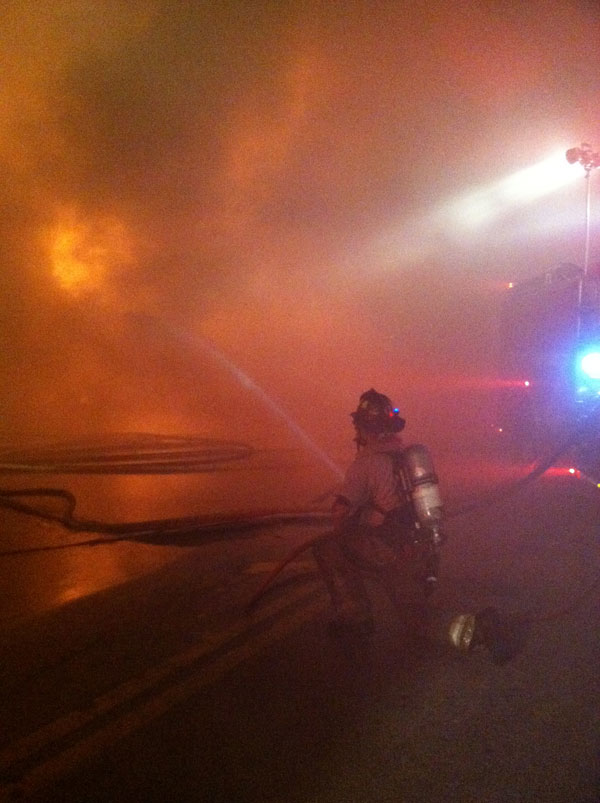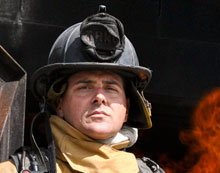
By Lee Forshner
To capture a moment in time from a fire scene is a priceless piece of information. Many firefighters desire to relive that moment, perhaps to justify the the memory, which in some way seems clouded by the actions of the incident. These split-second views from a high stress, fast-paced, and mentally and physically demanding time also have other uses, though. In many cases, we are able to recognize areas that could be improved upon. We can also reevaluate the decision-making process. But what happens once these snapshots go “viral”?
Take a look at the photo above. On a piece of paper, write down the first three points that come to mind. Look at the photo for what it is and be honest about it.
With the Internet at more and more people’s fingertips, social media and other media outlets have become a vast resource for scene photos, videos, and audio recordings. These files flying through cyberspace have brought out the downside to this preservation of history, namely “The analytical fire observer.” These observers are the ones who question the tactics or point out all the problems with the scene and never offer a solution. As a kid, I remember counting the days until I received Highlights magazine– the one that has all of the mistakes on the cover to circle. This mentality emerges when it comes to identifying areas of concern in scene pictures.
Emergency scenes are inherently stressful and full of uncertainty. When we look at scenes in the past tense, we can apply our training and derive lessons from them. How many of us use the incident we have documented as the next training lesson and include a step-by-step walk-through of issues that can be identified through the documenting media?
The information contained in these documents can be crucial in determination of incident outcomes. Some of what the observers identify as negatives are actually positives, if we can put the defense down and take a hard look at what we as responders are challenged with.
Over the past few years, more and more members of the fire service have been studying the physiological and psychological effects of operating at incident scenes. For instance, Paul Capo presents “The Physiology of Self-Preservation,” which discusses the body’s natural response to high-stress incidents and how immediate changes in your ability to make decisions combined with decreasing sense-functionality can be a recipe for disaster. Ric Jorge researched this even further and created the “Monster Within,” a truly intense realistic journey that adds to the physiological aspects of Capo’s class. This presentation has a hands-on component that felt so real I asked Ric to stop the drill after a Mayday was called and I could hear the firefighter screaming near me, never once thinking it was a part of the drill. Richard Gasaway has provided an amazing amount of information about what the mind can take in while being stressed and how to increase the recognition of critical material.
Much of this information has been used in the military for years and the fire service is now beginning to jump on board to understand the reasons for some of the mistakes we have recognized for years. The only problem here is the cultural stigma that has been associated with events, for example, observers saying, “That crew is clueless,” or “What were they thinking?”
The latter question is exactly the one we should be investigating. When one cannot duplicate the amount of external and internal distraction that was created when the shutter closed, one cannot truly understand why some things happened. The observers at this point begin to challenge the decisions and actions, but without having being mentally placed in those moments of restricted information, it’s difficult to say exactly what they would have done differently.
These moments of restricted information are the ones in which firefighters are using our gut instinct or intuition, or where a person is not capable of processing all the proper information available. John Maxwell stated “Intuition = Fact + Instinct + Conditions.” This means you’re taking the factual information about the scene, adding in the present operating conditions, and recalling past experience (recognition-primed decision making) to arrive at what seems to be the proper movement or thought for the incident. In hindsight, this may not accord with a textbook, standard operating guideline, policy, or a perceived common practice in which the observers hand down judgment.
In the book Blink: The Power of Thinking Without Thinking, Malcolm Gladwell says, “Understanding the true nature of instinctive decision making requires us to be forgiving of those people trapped in circumstances where good judgment is imperiled.” Now let’s revisit the photo exercise from above. What did you write? Did you find that your topics relate to more of the wrong and questioning actions? Without knowing the story behind the picture, it may be easy to identify the lack of a coat, the use of self-contained breathing apparatus (SCBA), poor engine placement, poor line selection, lack of pressure, the fact that no other visible lines are applying water, and so on.
Yet we lack the back story which accounted for these actions. This was a second-alarm commercial fire. On arrival there was light smoke that rapidly changed with a fast-moving westerly wind. This required the donning of SCBA because of smoke (hence the reason for not having a coat). The booster line was pulled secondary to a partial collapse. Because of the fire load created a large volume of fire (remember the wind condition), the line was being used to cool the tail end of the apparatus. The engine was supplying two large-diameter attack lines, and a ground monitor and an engine was located behind them so they could not reposition. Finally, I specifically asked the officer to point the line in that direction for the picture.
As I mentioned above, Highlights magazine created a mindset in which one looks and identifies all of the things wrong with the cover. Has this idea been instilled into us all from day one of our schooling as a child, with the way tests are formatted or the way we have addressed after-incident or after-training reviews? In many cases, we are focusing on the wrongs and looking for that to be corrected instead of focusing on what was right and building on the skills from there.
While reviewing this article, I got another opinion on this question. Is it the fault of the observers somehow? Is there a cultural or psychological difference between people who are able to look at a form of media and see the positive before criticizing? This conversation then led to what separated leaders from the rest of the population; was it the ability to remain positive and nonjudgmental and to identify when a glass is half-full? Right now I can’t answer these questions. But I ask: what type of observer are you?
The media exchange enabled by the Internet has allowed the fire service to truly grow and learn from so many other fire departments that are willing to share. The ground that is being paved with this type of openness and sharing should be recognized by the observers. Don’t destroy our members with negativity–develop our members with solutions.
 Lee Forshner is a staff captain in the training and safety division of Palm Beach County (FL) Fire Rescue and is responsible for development and implementation of fire-related training for the department.
Lee Forshner is a staff captain in the training and safety division of Palm Beach County (FL) Fire Rescue and is responsible for development and implementation of fire-related training for the department.


